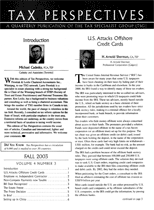
PDF Format
 Issue Contents Issue Contents
 All Issues All Issues
Fall 2003
Volume 3, Number 3
The information in Tax Perspectives is prepared for general interest only. Every effort has been made to ensure that the contents are accurate. However, professional advice should always be obtained before acting and TSG member firms cannot assume any liability for persons who act on the basis of information contained herein without professional advice.
The Estate Freeze — Old Tools Revisited
By Larry Frostiak, CA, CFP, TEP
Frostiak & Leslie Chartered Accountants Inc. (Winnipeg)
In the next ten years or so, there will be a monumental transfer of wealth, as a younger generation gets set to inherit business, real estate and other investment assets. Of course, the Canada Customs and Revenue Agency (CCRA) will also be anxiously waiting to benefit from the considerable tax windfall, as the transfer of these assets will ultimately trigger a deemed disposition immediately prior to death. This will result in capital gains and tax payable on those gains. Historically, an "estate freeze" has been an effective tool in limiting and quantifying the tax payable on such appreciating assets. An estate freeze attempts to minimize the tax by ensuring that the value of the taxpayer's estate will not increase after the freeze is implemented. Properly done, the maximum amount of any capital gain arising on death and the resultant tax thereon should be relatively predictable. Let's review a number of alternative methods of creating an estate freeze. 1. A Simple Sale At its simplest, a parent could sell an appreciating asset to the intended family member in exchange for a non-interest bearing note, payable on demand. The parent now holds only the note that will not increase in value; the family member now holds the appreciating asset. This simple freeze, however, creates a number of problems: - An effective loss of control over the asset:
- A potential income attribution problem if the recipient is a minor or a spouse;
- An immediate deemed disposition of the asset for tax purposes, with tax payable on any capital gains; and
- A potential funding problem on the note for the recipient.
Of course, if the taxpayer has unused capital losses available, a sale at fair market value today may be an effective means of implementing the estate freeze with no immediate tax cost. Otherwise, better techniques are available. 2. Sale or Gift to an Inter-Vivos Trust The control issue to the "freezor" can be addressed by effecting a transfer or sale of the asset to an inter-vivos trust. The taxpayer can then exercise control over how the property is used, either by the selection of trustees and/or by restrictions specified in the trust document. Care must be taken to ensure that the trust is appropriately structured, so that the income attribution rules of the Act are not triggered, where minor children or a spouse are beneficiaries of the trust. 3. Holding Company Freeze By incorporating and transferring growth assets to a holding company, it is possible to: - Freeze the asset values:
- Avoid income attribution;
- Defer taxation:
- Maintain control; and
- Transfer future appreciation to the next generation.
If an appropriately prepared election is filed with CCRA, the realization of capital gains can be deferred on a transfer to a corporation. Consider the following exanlple: Father holds a portfolio of marketable securities with potential future appreciation. The cost is $2,000,000 and the fair market value, $5,000,000. An estate freeze in favour of a holding company could be implemented, with the common shares of the holding company owned by an inter-vivos family trust. Consideration issued by the holding company would include voting preferred "freeze" shares issued to the father, thereby ensuring that he retains voting control over the corporation. Care should be taken to ensure that a benefit is not deemed conferred on the trust or the children. For this reason, it is imperative that proper valuations are used. The benefits of this structure include: - Effective freeze of taxpayer's assets at $5,000,000
- Deferral of capital gains;
- Effective transfer of growth in the portfolio to the inter-vivos trust for children; and
- Ability to manage income attribution issues.
4. Section 86 Reorganization of Capital An estate freeze can also be achieved by means of a share capital reorganization within the corporate structure. A new holding company is not required. The existing capital of the corporation can be reorganized by exchanging (on a tax-deferred basis) all of the common shares of the corporation for non-participating preferred "freeze" shares having a value in aggregate, equal to the value of the "old" common shares so exchanged. The transfer of the future growth in the corporation is achieved by issuing "new" common growth shares to the intended recipients. The following is an illustration of a share capital reorganization. The biggest advantage of a share capital reorganization is that it does not require the filing of tax election forms. Therefore, there is less scrutiny by CCRA. It also avoids the need for a new company. Summary There are obviously a number of "Estate Freeze" structures available. Space permitting, more would have been described. They provide the professional planner with many effective tools to accomplish a client's estate planning needs.
| 



